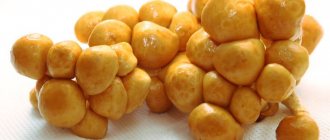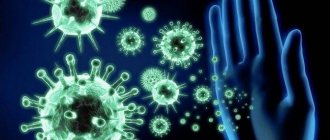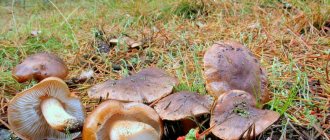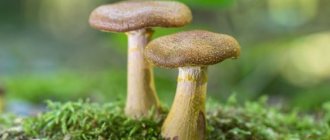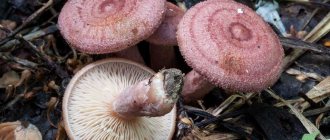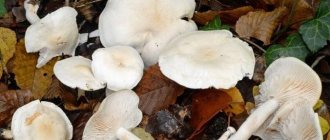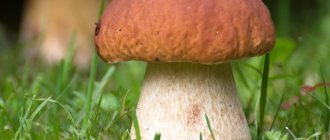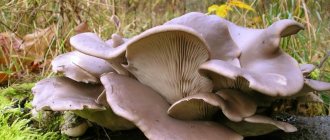Poplar honey fungus is an edible, cultivated mushroom, one of the most delicious. Thanks to its crispy flesh, as well as its pleasant spicy taste and subtle wine aroma, it is highly valued in Mediterranean cuisine. Belongs to the genus Agrocybe of the family Strophariaceae, group lamellar.
Honey mushrooms are one of the most famous and popular mushrooms among lovers of quiet hunting. And although they are inferior in appearance to the beautiful boletus, boletus and boletus, they also grow to a respectable size: the height of many representatives can reach 15 cm. Honey mushrooms grow in large colonies on fallen tree trunks and stumps and are extremely prolific. Once you find such a family, you can consider that the quiet hunt was a success.
Some types of honey mushrooms are quite highly valued: they are cultivated both on an industrial scale and by amateurs at home. In addition to poplar honey agaric, these are winter honey agaric (Japanese name - enokitake), bulbous honey agaric, etc.
Poplar honey fungus is a cultivated plant. Its high, refined taste qualities were appreciated by the sophisticated gourmets of Ancient Rome. It was put on a par with such delicious mushrooms as truffles and porcini mushrooms.
Currently, this species is highly valued in the cuisine of Mediterranean countries such as Italy, France, etc., where it is widely cultivated. The Italian name for poplar honey fungus is piopino. Popular in the best restaurants in Europe. But the beneficial properties of poplar honey fungus are not limited to this.
The pulp is fleshy, dense, crispy, and retains its texture well during cooking. The mushroom is versatile and is widely used in cooking to prepare a wide variety of dishes. Poplar honey fungus showed itself well in preparations for the winter.
Poplar honey fungus also has medicinal properties and has found application not only in folk but also in official medicine for the treatment of diseases such as hypertension, migraines, and normalizes the functioning of the digestive system and metabolism.
The chemical composition of poplar honey fungus contains substances that have antibiotic, antifungal, and antiparasitic effects. Based on this, the pharmaceutical industry released the drug Agrocybin, which is effective against a large group of parasites, fungi and bacteria.
This type also contains a special substance – lectin, which has a powerful inhibitory effect on some forms of cancer. It is also used for preventive purposes.
Important! The information presented in the material is for informational purposes only. Be sure to consult an experienced professional before use.
Poplar honey fungus. Latin name: Agrocybe aegerita.
Poplar honey fungus. Other names : poplar foliota, agrocybe poplar (poplar), agrocybe, black poplar mushroom, pioppino.
Related species
What kind of mushrooms are honey mushrooms?
Honey mushrooms are a group of mushrooms that includes a fairly large number of species belonging to different genera and even families. What they have in common is that most of them grow on living or dead wood.
Honey mushrooms are quite prolific and usually form large families and clusters, connected by the base of the legs, which allows the mushroom picker to quickly fill his baskets with mushroom trophies.
Information! Honey mushrooms are not a separate species, but a group of mushrooms belonging to different genera and families.
Types of mushrooms
Beginning mushroom pickers often ask the question: what kinds of mushrooms are there? The poplar honey agaric has many relatives. First of all, you should pay attention that there is a genus of honey fungus (Armillaria), which includes:
- autumn honey fungus – Armillaria mellea;
- thick-legged honey fungus – Armillaria gallica;
- bulbous honey fungus – Armillaria bulbosa;
- dark honey fungus – Armillaria ostoyae, etc.
Honey mushrooms also include some species from the genus Marasmius:
- meadow honey fungus (meadow honey fungus) – Marasmius oreades;
- garlic honey fungus (common garlic mushroom) – Marasmius scorodonius;
- cheese honey fungus – Marasmius bulliardii;
- sinewy-plate honey fungus (leaf rotting mushroom) – Marasmius epiphyllus, etc.
Honey mushrooms belonging to other genera and families:
- summer honey fungus (Kuehneromyces variable) – Kuehneromyces mutabilis – genus Kuehneromyces (Kuehneromyces), family Strophariaceae;
- winter honey fungus (Flammulina velutipes) – Flammulina velutipes – genus of Flammulina, family Physalacriaceae;
- yellow-red honey fungus (yellow-red honey fungus) – Tricholomopsis rutilans – genus Tricholomopsis, family Tricholomataceae;
- mucous honey fungus (Oudemansiella mucosa) – Oudemansiella múcida – genus Oudemansiella, family Physalacriaceae, etc.
Spreading
Foliota poplar.
Poplar honey fungus grows on a wood substrate. It can be grown under artificial conditions, since this mushroom is very unpretentious to the conditions. It can grow on wood for up to 7 years, during which time it completely destroys the substrate. By the way, the mass of the harvest of this mushroom can be up to a quarter of the mass of the substrate. This species grows in large clumps.
Similar species and false look-alikes
During a “quiet” hunt, the ability to recognize each individual type of mushroom and distinguish it from similar edible species is of great importance. But the most important thing is to learn to distinguish it from inedible and poisonous mushrooms that are similar in appearance, which can harm not only health, but sometimes even human life.
Fortunately, there are no inedible or poisonous counterparts with which this species can be confused. The poplar honey agaric has the greatest external resemblance to the related species of the honey agaric genus Armillaria, but these are edible mushrooms and if they end up in the basket when collected, nothing bad will happen. Studying the differences between one species and another is of interest to those interested in the world of mushrooms. How to distinguish poplar honey fungus
Important! Poplar honey fungus has no external resemblance to inedible or poisonous mushrooms.
Honey fungus (Armillaria tabescens)
Another name for the mushroom is oak or ringless honey fungus. Belongs to the III or IV category of nutritional value. Compared to poplar honey fungus:
- The color of the cap is more reddish - yellow, reddish-brown.
- In young mushrooms, the central part of the cap is covered with dark scales, which disappear in adulthood.
- Although it grows mainly on dead wood, it can occasionally be found on living trees, both deciduous and coniferous. Preference is given to oak.
Information! The fruiting season of the drying mushroom is June-July until late autumn.
Dark honey fungus (Armillaria ostoyae)
Another name is honey fungus (spruce). Belongs to the IV category of nutritional value. Has the following distinctive features:
- Cap color: reddish-yellow, brown, noticeably darker in the center and lighter towards the edge.
- The cap is densely covered with darker scales.
- Along the edge of the cap there are fringed flakes - the remains of a private bedspread.
- Unlike the poplar honey agaric, whose spore powder is rusty-brown, the dark honey agaric is white.
- Settle on both living and dead trees and stumps.
Information! The dark honey fungus bears fruit from late August to early November.
Contraindications
In addition to the benefits, it should be noted that summer honey mushrooms can cause harm to the body. In this case, the first “suffering” organ is the pancreas. If consumed incorrectly or excessively, a person can develop pancreatitis and other gastrointestinal diseases. In other cases, they do not pose a serious threat to the body, so everyone can consume them in moderation.
Who shouldn't eat
There are five categories of people who should stop using temporarily. For some, there are even contraindications that prohibit the use of “tree inhabitants” for health reasons, which is why they cannot be eaten at all. The first category includes women who are pregnant. They are highly discouraged from using the product, since the child is not yet ready for such stress. This can also disrupt formation processes. Not recommended during breastfeeding.
The second type is people who suffer from diseases of the gastrointestinal tract (Gastrointestinal tract). Diseases cause weakening of the body, decreased immunity, which is why you can get poisoned even with such a harmless product. The third type is children
Particular attention should be paid to children who are between seven and ten years old. This type of product is completely contraindicated for them.
If we are talking about a child from 12 to 13 years old, then he can limit himself to small portions. Thanks to a more mature body, the child can be satisfied with the product.
How summer honey mushrooms grow.
The fourth category is allergy sufferers. Allergies are a good reason to stop using. In addition, a person may have individual intolerance, which also serves as a compelling reason for refusing honey mushrooms. The fifth category is hypertensive patients. Here the category is divided into two types of people: hypertensive patients and those who suffer from heart disease. Mushrooms should be limited to people suffering from heart disease or a weak cardiovascular system.
You should also know a few simple rules before eating the product. Firstly, you can’t eat them raw. They must be prepared correctly. Secondly, people who have a weak stomach should limit their intake. Thirdly, honey mushrooms can be easily confused with honey mushrooms, so it is necessary to carefully select mushrooms. This will avoid unnecessary problems and save you from possible poisoning.
Botanical description
hat
The cap of the poplar mushroom is round, with thin, wavy edges in older mushrooms. When young, it is hemispherical; as it grows, it gradually opens up and becomes convex and finally almost flat in mature specimens. In the central part, some representatives have a wide flat tubercle.
The skin of the poplar honey fungus is initially velvety, abundantly covered with mucus. In adult fruiting bodies, it becomes covered with a network of cracks, the mucus becomes watery and dries out a little.
The color of young mushrooms in the central part is yellow, dark brown and lighter - ocher, yellowish-beige, closer to the edge. As it matures, it gradually lightens to a beige, whitish-yellowish color.
Diameter: 3-8 cm.
Hymenophore
The hymenophore (lower part of the cap) of the poplar honey agaric is a thin, wide, frequent plate, closely adherent to the stem. The color at a young age is white, yellow, beige, gray, then gradually darkens to brown, gray, rusty brown in older specimens.
Spores are smooth. Color: rusty, dark brown. Size: 10-12 x 5-6 microns. Color of poplar honey fungus spore powder: rusty brown.
Leg
The stalk is central, round, dense, smooth or fibrous, often curved. It has a tall, thin ring, which represents the remains of a common blanket. Above the ring it is densely pubescent.
Color: whitish, cream. When ripe, both the ring and the entire stem are covered with fallen spores, due to which they acquire a brown color.
Height of the leg of poplar honey fungus: 5-10, up to 15 cm, diameter: 1-2, up to 3 cm.
Pulp
The flesh is fleshy, dense, crispy. Color varies from white to light brown. Taste: pleasant, spicy, mealy. Smell: delicate, winey.
Important! The external characteristics of poplar honey fungus may vary depending on the area of growth, climate, weather conditions, on which tree the mushroom has settled, etc.
Spring Honey fungus or Wood-loving collibia Gymnopus Dryophilus
Spring Honey fungus or Wood-loving Kollibia Gymnopus Dryophilus
Edible mushroom from the genus Gymnopus, family Negniumaceae, formerly part of the genus Kollibia, family Ordinaceae.
Alternative names
Kolybia Dubravnaya, Kolybia Oak-loving, Denezhka Forest-loving, Money Ordinary, Forest meadow honey fungus.
Appearance
The cap is up to 6 cm in diameter, hemispherical in young specimens, spread out in mature fruiting bodies, often with plates visible through the flesh of the cap. The color of the cap greatly depends on the degree of humidity - from brown to light red in the center, and gray - white - waxy at the edges.
The hymenophore is lamellar, the plates are white or yellowish, frequent and thin, weakly adherent, white spore powder.
The stalk is up to 9 cm long and up to 0.8 cm thick, flexible and thin, fibrous-cartilaginous, often with pubescence at the base, colored similarly to the central zone of the cap, cylindrical in shape, sometimes with a thickening at the base.
The pulp is thin and light, with a mild taste and smell.
Where and when does it grow
Grows from May to November in mixed forests with pine and oak, on rotting wood or deciduous litter.
Culinary value
This species is edible, in some sources it is positioned as conditionally edible, but without instructions to boil the fruiting bodies before consumption.
It is not particularly popular among collectors due to its small size and lack of special gastronomic advantages.
Habitat
Poplar honey fungus is a saprotroph and, unlike autumn honey fungus, which mainly affects living trees, it grows exclusively on dead wood. Although it bears fruit not as abundantly as other types of honey mushrooms, it also creates large dense families and clusters in which the mushrooms are connected by the base of the legs.
Information! Poplar honey fungus is unpretentious and can be grown at home. It is enough to purchase mycelium (mycelium) in specialized stores.
Where does poplar honey fungus grow?
The fungus lives on deciduous trees. Prefers poplar, but is also found on willow, birch, elm, chestnut, linden, alder, ash, and less commonly on elderberry and fruit trees.
Since the use of poplar honey agaric is quite widespread, it is cultivated on an industrial scale.
The first mushrooms, depending on the area, appear in May-June and continue to delight lovers of “quiet” hunting until October – early November. Fruits in waves.
Important! Mushrooms tend to accumulate all kinds of toxins and heavy metals from the soil. Therefore, to harvest poplar honey mushrooms, you need to choose environmentally friendly places, far from industrial enterprises, roads, etc.
Galerina Bordered
Dangerous Double Honey Honey
The Summer Honey Fungus has a very dangerous, deadly poisonous double - Galerina Bordered, which you can read about in detail here. It is possible to distinguish them from each other, but not so easy, especially considering the changeable appearance of the honey mushroom. Galerina is slightly smaller in size and has not a scaly, but a fibrous surface of the lower part of the leg, but these signs, in terms of accuracy, are not so reliable. It is best to distinguish these species by habitat. Galerina grows on coniferous stumps, and the most reliable way not to grab it in the basket is not to collect Summer Honey Mushrooms under coniferous trees.
How to store
Poplar honey fungus is a universal mushroom, thanks to its dense, elastic, crispy pulp, which retains its texture well and does not fall apart during cooking, it has proven itself well in all types of preparations.
Important! Poplar honey fungus is a perishable product and must be processed no later than 24 hours after collection. In the refrigerator, this period can be extended to three days.
The least troublesome way to store poplar honey mushrooms for use out of season is drying, in which you do not need to wash and boil the mushrooms beforehand, just clean them of debris with a sponge or toothbrush. To ensure that the fruiting bodies are dried evenly, they are selected of the same size, large specimens are cut, strung on a thread and dried in the open air. You can also use an oven, stove or electric dryer for drying. With this method, poplar honey mushrooms retain a maximum of useful substances in their composition.
Freezing is also a fairly quick and economical way to preserve this species for the winter. Frozen poplar honey mushrooms are a semi-finished product, immediately ready for basic culinary processing.
Of course, these mushrooms are delicious when salted and pickled. They are preserved, both as a single component and as part of various vegetable stews.
Information! This type is a low-calorie product. The calorie content of poplar honey fungus is 20-22 kcal per 100 grams.
Beneficial features
The composition of all edible coral mushrooms is approximately the same.
The beneficial properties of this group were appreciated even earlier than food properties, so people have long used them for both health and beauty. The unique and inimitable composition determines the following properties:
- removal of toxins and radionuclides;
- regulation of liver function and lowering blood cholesterol;
- stabilization of the cardiovascular and nervous system;
- smoothing out changes in blood pressure;
- improvement of hematopoietic processes;
- anti-inflammatory effect;
- confirmed antiallergic effect;
- improving the processes of remembering and reproducing information;
- inhibitory effect on tumors.
Such a large list of beneficial properties of mushrooms is due to the presence of glycogens in the composition, which are used during the fight against HIV, stress and premature aging. The effect on the immune system is comparable to that of maiatake, a mushroom with proven effectiveness in restoring immunity.
In medicine
The Chinese were the first to use such mushrooms in medicine. For many centuries they were used at the level of traditional medicine, but several years ago Israeli scientists conducted detailed studies, which were later confirmed by specialists from many countries.
Research has revealed that this group of fungi has an effect on the body comparable to that of antibiotics and antidepressants. Based on them, drugs are developed aimed at activating specific antibodies and eliminating a wide range of bacteria and viruses.
Erinocin E, contained in edible corals, actively fights Alzheimer's disease, slowing down its development. They have also proven to be an indispensable tool in the treatment of cancer, both for inhibiting the growth of cancer cells and for increasing the body’s immunity after chemotherapy. These drugs are also used to combat helminthiasis.
The presence of vitamins, micro- and macroelements, fiber, polysaccharides and essential amino acids allows the use of coral mushroom powder as a dietary supplement. In addition, doctors recommend it as a means of removing toxins from the body of active smokers.
In cosmetology
Research in the pharmaceutical field has also been useful for cosmetologists, since it turned out that edible corals are able to retain moisture in the skin several times more effectively than the recognized leaders - glycerin or hyaluronic acid.
The sensational discovery of cosmetologists has made it possible to produce many cosmetic products that can slow down the aging process. The presence of vitamin D accelerates metabolism in dermal cells. Natural polysaccharides serve as conductors of all useful substances into deeper layers.
In cooking
After edible corals began to be grown on an industrial scale, they became available not only to those lucky people who live in the regions where they grow, but also to all other people.
Chefs value this product for its low calorie content and high degree of digestibility, which makes it a dietary product suitable for vegetarian or therapeutic diets. The list of dishes that are prepared using it includes soups, salads, appetizers and even desserts.
Only young specimens are suitable for cooking, since as they ripen, bitterness begins to appear. It is not dangerous to health, but spoils the taste.
Those who are afraid to use this product raw recommend first boiling it for 15 minutes in salted water. Most often, these mushrooms are fried or stewed with vegetables. They are often marinated, salted, cooked in Korean, boiled in soups, or grilled.
The branches are often dried, and in winter they are soaked and added to soups. Sometimes they are added to sandwiches or seafood dishes.
Due to the fact that they produce a large harvest, these crops are happily grown on an industrial scale. It is quite difficult to purchase them raw, but if you try, you can find them at the market or in the supermarket. In most cases, this delicacy is sold in the form of canned or pickled snacks.
Recipes with poplar honey fungus
Beans with poplar honey mushrooms (Neapolitan cuisine)
Ingredients
White beans - 500 gr., poplar honey mushrooms - 250 gr., onion (medium) - 1 pc., tomatoes - 150 gr., olive (vegetable) oil - 6 tbsp., salt and spices - to taste.
Preparation
- Rinse the beans. Pour in water, bring to a boil and let simmer for 3-5 minutes. Remove from heat, cover and leave for half an hour. After this, cook until done.
- Pour the prepared mushrooms with water, bring to a boil and boil for 10-15 minutes. Drain the poplar honey mushroom decoction.
- Wash the tomatoes, pour boiling water over them and remove the skins. Cut into small pieces.
- Fry the onion in vegetable (preferably olive) oil until golden brown. Remove the onion from the oil.
- Place the boiled poplar mushrooms in the frying pan in which the onions were fried and simmer for 3 minutes.
- Add the prepared tomatoes and continue to simmer for about 7-10 minutes.
- Add the beans to the vegetables, add a little of the liquid in which they were cooked, add salt and cook until cooked (3-5 minutes).
- At the end, add spices (black, red, allspice) and herbs (parsley, basil) to taste.
Note
The original recipe does not use onions in the dish itself. It is only needed to flavor the oil. But, if you wish, you can leave it.
Where does the poplar row grow?
Poplars grow in large families and can appear around poplars in parks, forest belts, along roads, ravines, and near ponds. In just a few years, the population can occupy an entire clearing near the trees. The poplar species prefers dry, loose soil; most often, their mass distribution is observed on sandy soils.
The natural habitat of poplar rows is North America, Canada, all of Europe and Central Asia. Rows grow in Ukraine, Belarus, in the south of Russia, in the middle zone to the Far East.
